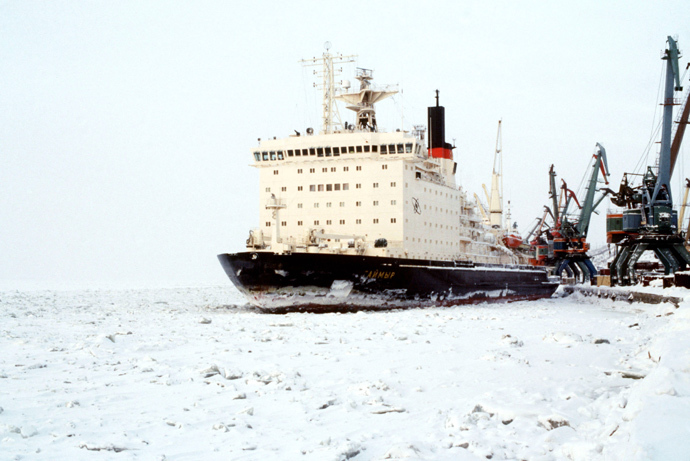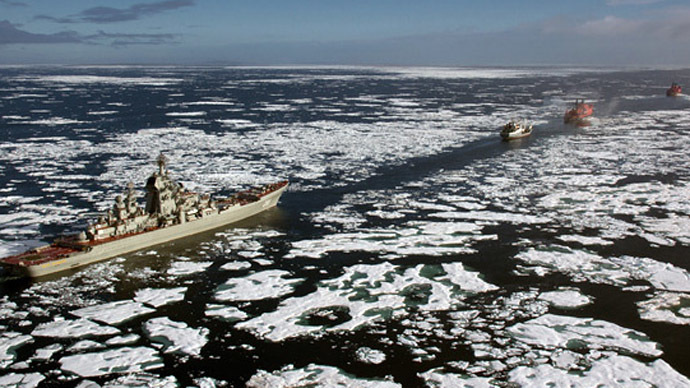Russia will create forces in the Arctic in 2014 to ensure military security and protect the country’s national interests in the region, which President Vladimir Putin has named among the government’s top priorities.
Russia is returning to the Arctic and “intensifying the development of this promising region” so it needs to “have all the levers for the protection of its security and national interests,” Putin said on Tuesday at an expanded meeting of the Defense Ministry Board.
He ordered the ministry to complete the formation of new military units and infrastructure in the Arctic next year.
"I would like you to devote special attention to deploying infrastructure and military units in the Arctic," the president said in televised remarks.
Russia is reinstating its military base in the Novosibirsk Archipelago (New Siberian Islands), which had been abandoned by the military in 1993, after the dissolution of the Soviet Union. The islands “have key meaning for the control of the situation in the entire Arctic region,” Putin told the top military brass.
This year, Russia has also started restoring its Arctic airfields including one called “Temp” on Kotelny Island near the city of Norilsk. It is also overhauling urban facilities in Tiksi, Naryan-Mar, and Anadyr.

The country is set to continue the revival of other Russian northern airfields as well as docks on the New Siberian Islands and the Franz Josef Land archipelago, Defense Minister Sergey Shoigu said, speaking at Tuesday’s meeting.
“There are plans to create a group of troops and forces to ensure military security and protection of the Russian Federation's national interests in the Arctic in 2014,” Shoigu confirmed.
Additionally, Russian Senator and well-known polar explorer, Artur Chilingarov, suggested reviving the Academy of Sciences’ Polar Commission – a research institution which existed until 1936.
Back in September, Russia announced it was resuming its permanent Arctic military presence. In a symbolic move, it sent 10 warships and nuclear-powered icebreakers along the Northern Sea Route. This is a shipping lane between the Atlantic and the Pacific Oceans, which runs from the Russian northern port city of Murmansk, along Siberia and the Far East.
In recent years, as the race for the Arctic intensified, Russia has repeatedly reiterated that it is set to retain its position in the region for both security and economic reasons, as well as to preserve its national integrity.

However, other Arctic nations are not going to give up either in their intention of grabbing a share of the region, believed to be rich in oil, natural gas, and deposits of gold and platinum. According to a US Geological Survey, about 90 billion barrels of oil and 1,670 trillion cubic feet of natural gas are there, making up about 10 percent of the world's petroleum resources. The dominant portion of these resources is hidden beneath ice that is shared between five nations bordering the Arctic: Canada, Denmark, Norway, the Russia and the US – who have been in a bitter dispute over how to divide up the ‘pie’.
According to the UN Convention on the Law of the Sea, an economic zone belonging to a state is limited to 200 nautical miles from the coastline. That area can only be extended if a country provides evidence that the continental shelf is a geological extension of its territory.
Canada confirmed on Monday that it is preparing to include the North Pole as part of its Arctic Ocean seabed claim in the multi-country push to prove jurisdiction over further territory in the area.
Since 2007, Russia has organized several expeditions to prove that an underwater Arctic mountain range, the Lomonosov Ridge, is part of its own landmass. It says the ridge is a continuation of the Siberian continental platform and it is not isolated from the Russian plateau.
US President Barack Obama in May unveiled a strategy for the Arctic, asserting that nations must protect the region's fragile environment and keep it free from conflict. The plan also made it clear the US does not want to be left behind as the other countries eye natural resources and exploit potential new sea routes.

